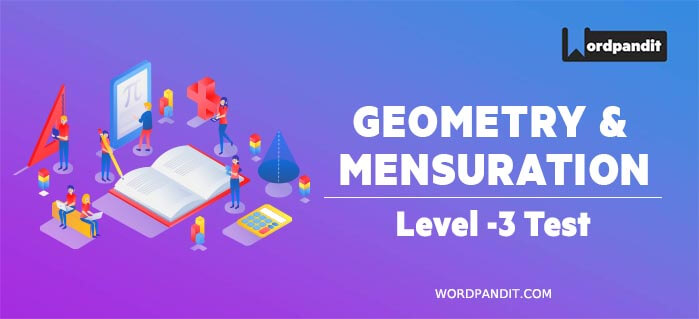- This is an assessment test.
- To draw maximum benefit, study the concepts for the topic concerned.
- Kindly take the tests in this series with a pre-defined schedule.
Geometry and Mensuration: Level 3 Test 4
Congratulations - you have completed Geometry and Mensuration: Level 3 Test 4.You scored %%SCORE%% out of %%TOTAL%%.You correct answer percentage: %%PERCENTAGE%% .Your performance has been rated as %%RATING%%
Your answers are highlighted below.
Question 1 |
$\displaystyle \begin{array}{l}If\,a,b,c\,\,are\,\,the\,\,sides\,\,of\,\,a\,\,triangle\,\,and\,\,{{a}^{2}}+{{b}^{2}}+{{c}^{2}}=ba+ca+ab\\then\text{ }the\text{ }triangle\text{ }is\end{array}$
Equilateral | |
Isosceles | |
Right-angled | |
Obtuse-angled |
Question 1 Explanation:
$ \displaystyle \begin{array}{l}{{a}^{2}}+{{b}^{2}}+{{c}^{2}}=ba+ca+ab\\is\text{ }an\text{ }identity\text{ }when\text{ }a=b=c\\Thus\text{ }the\text{ }correct\text{ }option\text{ }is\text{ }\left( a \right)\end{array}$
Question 2 |
In the given diagram, ABCD is a rectangle with AE=EF =FB. What is the ratio of the area of the triangle CEF and that of the rectangle?


1: 4 | |
1: 6 | |
2: 5 | |
2:3 |
Question 3 |
In triangle DEF shown below, points A, B and C are taken on DE, DF and EF respectively such that EC= AC and BF= BC. Angle D= 40 degrees then what is angle ACB in degrees?


140 | |
70 | |
100 | |
None of these |
Question 4 |
In the given figure, ACB is a right angled triangle, CD is the altitude. Circles are inscribed within the triangle ACD, BCD. P and Q are the centres of the circles. The distance PQ is?
5 | |
√50 | |
7 | |
8 |
Question 4 Explanation:

$ \begin{array}{l}Now\,\,{{15}^{2}}-{{x}^{2}}={{20}^{2}}-\left( 25-x \right){}^{2}\\x=9cm\\Thus\text{ }area\text{ }of\text{ }the\text{ }triangle~ADC=\frac{1}{2}\times 9\times \sqrt{{{15}^{2}}-{{9}^{2}}}=54\,c{{m}^{2}}\\The\text{ }area\text{ }of\text{ }the\text{ }triangle\text{ }BCD=\frac{1}{2}\times 12\times 16=96\,c{{m}^{2}}\\The\text{ }radius\text{ }of\text{ }the\text{ }circle\text{ }inside\text{ }ADC=\frac{2\left( \frac{1}{2}\times 9\times 12 \right)}{15+9+12}=3cm\\The\text{ }radius\text{ }of\text{ }the\text{ }circle\text{ }inside\text{ }BCD=4cm\\Thus\text{ }one\text{ }radius\text{ }is\text{ }bigger\text{ }than\text{ }the\text{ }other.\\\begin{array}{*{35}{l}} Therefore\text{ }the\text{ }length\text{ }of\text{ }PQ\text{ }=\text{ }7\text{ }cm \\ Q{{Q}^{''}}~=1\text{ }cm \\ \begin{array}{l}Therefore\text{ }the\text{ }required\text{ }distance\text{ }=\sqrt{{{7}^{2}}+{{1}^{2}}}\\=\sqrt{50}\end{array} \\ \end{array}\end{array}$
Question 5 |
In the figure below, ABCD is a rectangle. The area of the isosceles right triangle ABE -7 cm2; EC= 3 (BE). The area of ABCD (in cm22) is:


21 | |
28 | |
42 | |
56 |
Once you are finished, click the button below. Any items you have not completed will be marked incorrect.
There are 5 questions to complete.
List |













